A dreadful winter season so far, but on January 8th there was a clear-ish night when I was able to complete the colour data for NGC3079 in Ursa Major. All details here. Full size
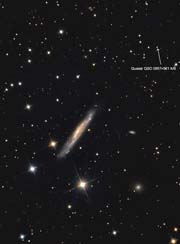
|
A dreadful winter season so far, but on January 8th there was a clear-ish night when I was able to complete the colour data for NGC3079 in Ursa Major. All details here. Full size |
 |
|
Although there was a bright Moon in the sky on 21st January which I also imaged, the air was nevertheless very clear, so I later decided to try for the 'Seagull' nebula, IC2177 in Canis Minor. This emission nebula is well suited for the use of narrowband filters, being particularly bright in Hydrogen-alpha, so worth a try. Also the large target needs a wide field, and the QSI 683 on the TS65 Quad was just enough to cover the vast majority of the gas cloud. But it is very low in my sky, never rising above 24 degrees, so imaging is limited to an hour or so either side of the meridian. Unfortunately it clouded over before I was able to capture any more than 9 Ha images, and only one on 23rd January, so for now this is the monochrome result. But looking promising - plenty time this season to acquire more data if the weather plays even remotely fair! 10 x 10 minute Ha subs binned 2x2. QSI683 with SX AO unit on TSquad.Full size The weather didn't improve much over the next few weeks, but I eventuually got more data on 11th February. So this final image consist of 14 x H-alpha , 4 each OIII and SII, combined HOS. All 10 minutes binned 2x2. Plus 10 x 5 minutes Luminance and 4 x 5 minutes each RGB all binned 2x2. Full Size |
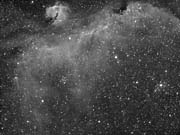
|
|
What a dreadful season! Notable for rain, snow, sleet, wind and a serious lack of dark moonless nights. I had not been entirely happy with my image of 9th magnitude Messier 85 in Coma Berenices from March 2020 which was imaged in very poor seeing conditions, and resolved to try and improve it. The poor weather led to a number of attempts with this final result, using data from the nights of 11th February and 13th March 2021 along with colour data from the original image. A slight improvement, and probably the best I can hope for. The more interesting spiral galaxy is magnitude 10.9 NGC 4394 and the faint small galaxy to the right of M 85 is magnitude 14.8 IC 3292. QS 683 on RC10 with SX AO unit. Full size |
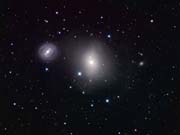 |
|
6th magnitude open cluster NGC 1746 in Taurus contains two other classified open clusters, NGCs 1750 and 1758, but it would appear that 1746 is the dominant. Quite large at about 50 arc-minutes. I could have gone for a close up, and may yet, but there is a fainter open cluster nearby, NGC 1802, this is to the far centre left of the image, so to get both in the frame I used my 420 mm focal length TSquad refractor. As can be seen, both the clusters are quite loose. Data obtained over two nights, 11th and 13th March 2021. The target was well towards the West limiting my imaging time - I would have preferred to image it sooner in the year, but the weather did not play fair! QSI683 with SXAO. Luminance 10 x 5 minutes, RGB each 7 x 5 minutes, all unbinned. Larger image (1.26MB) |
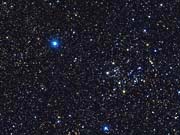 |
|
NGC 2506 is a bright (mag 7.6) quite dense open cluster in Monoceros. I first imaged it in 2020, but at a larger field of view so thought it worth a revisit. Low for me, never rising above 24 degrees. The night of 16th March was promising although with a young crescent Moon. A little late in the year, already past the meridian when the sky was dark enough, so low in the haze and the stars are slightly blurred. Not a focus problem, just down to sky conditions. But by keeping the exposures short I didn't saturate the stars so was able to show the colours and am reasonably satisfied with the image. QSI683 on RC10 with SX AO. Luminance 15 x 2 minutes, RGB each 8 x 2 minutes, all binned 2x2. Full size. |
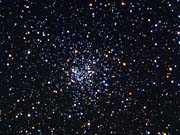 |
|
A Nova in Cassiopeia was confirmed as a 'Classical' nova following its discovery by Yuji Nakamura of Japan on 18 March 2021. Coordinates (epoch 2000) were confirmed as RA 23h 24m 47.73s, Dec +61° 11’ 14.8”. The star was not shown in Skymap Pro, but I located it in Stellarium at a magnitude of 14.4 I was able to collect some data on 21st March with this result. Cropped to put the pink-ish coloured nova in the centre of the image. The other two bright stars are magnitudes 6.6 and 9.1, so it would appear that the nova is in the region of magnitude 7.5 Quite a bang! QSI on RC10. A bit of a mix up with the hurried exposures, no flats or darks, but came out ok! Larger image This image appeared in the May 2021 Astronomy Now Gallery |
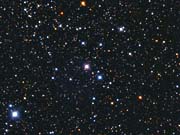 |
|
I first came across the interesting magnitude 10.5 galaxy NGC 4274 in Coma Berenices when browsing Skymap Pro in early March 2021 for proposed targets in that area already on my 'Must do' list. The Skymap image shown here immediately made me think 'Saturn Galaxy' and I resolved to try and image it. |
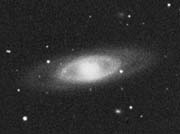 |
|
Unfortunately as has been the case most of this season, the weather did not play fair, and a couple of aborted sessions followed, completely ruined by haze and clouds although a short clearance on 21st March allowed me to collect the star field around NovaCas 2021 above. But eventually the night of 3rd. April started out clear, and I was able to proceed. Even though the sky appeared clear, and I had a full 6 hours of imaging time, disappointingly many of the earlier subs had unexpectedly high background levels probably due to thin haze and I had to discard more than half of them. So ended up with Luminance 11 x 10 minutes binned 2x2, RGB each 4 x 10 minutes binned 2x2. QSI683 on RC10 with SX AO unit. I may try for more good data if given the opportunity over the next week or so, but the twilight nights of Northern Summer are fast approaching! Full size |
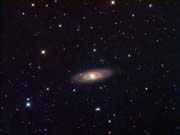 |
|
Early April 2021 saw several days with a blast of Arctic air which brought some clear skies. The night of 5th April started off with excellent conditions, unfortunately by shortly after 1am on 6th clouds had moved down from the North ending my imaging run (as usual click on the thumbnail). It would seem that the clouds did not affect the South of England until the night was over So they would have had a good session. Sod's law! |
|
|
Fortunately the following night of 6th was again forecast to be clear, and this time stayed that way and I was able to return to the previous night's target of NGC 5363 and associated galaxies in Virgo. Unfortunately some thin cloud part way through the night caused the scrapping of several sub frames, nevertheless I collected enough altogether to produce a satisfactory image. QSI 683 camera with Starlight Xpress AO unit on RC10. Luminance 16 x 10 minutes, RGB each 8 x 10 minutes, all binned 2x2. Full Size A nice range of galaxy types. Clockwise from top right the individual galaxies are: NGC 5356 mag 13.0, NGC 5360 mag 13.6, NGC 5317 mag 10.4, NGC 5363 mag 10.5. North is approximately up. |
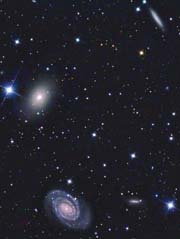 |
|
The mag 10.5 edge on galaxy NGC 5746 in Virgo is quite low for UK observers, but worth attention particularly because of it's similarity to big brother NGC891. The night of 9th April 2021 was forecast to be clear, but as is the way of things it wasn't free of clouds until almost midnight, so 1 1/2 hours of imaging time lost. Then a couple of problems lost another half hour - a mysterious extra diffraction spike appeared on the first couple of images, so I stopped the run and searched for a source. A floating bit of tape (from the secondary dew heater lead) was removed and that seemed to do the trick. Then I refocused before continuing. So a little short of data but happy enough with the result except for the substantial glow from the nearby 3.7 magnitude 109 Virginis. Dark nights are soon history for a few months, I may revisit this season, but with different framing to lose that bright glow. Or crop the image. Or just leave it as it is for artistic effect! Anyway, QSI683wsg with SX AO unit on RC10. Luminance 11 x 10 minutes, RGB each 4 x 10 minutes all binned 2x2 Full size |
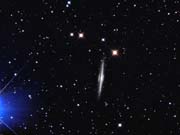 |
|
This group of galaxies in Coma Berenices is known as the Box Galaxies, Hickson 61. It consists of four relatively faint components. Starting with the long blue one and moving clockwise they are 12.7 mag NGC 4173, 12.2 mag NGC 4169, 13.5 mag NGC 4174 and 13,4 mag NGC 4175. What looks like a fuzzy red star near the right hand end of NGC 4174 is a tiny galaxy, PGC (LEDA) 213947. NGC 4173 is not believed to be part of the group, just a chance alignment and nearer to us than the others. The remaining easily seen galaxy towards the right edge is mag 15.1 UGC 7190. I got a small amount of data on the night of 10th April 2021, but clouds soon moved in. However the following night cleared nicely around 11.30 pm (BST) and stayed clear, and I was able to collect more data. So this image consists of Luminance 13 x 10 minutes, RGB each 7 x 10 minutes all binned 2x2. QSI 683 on RC10 with SX AO unit. Despite the reasonable number of exposures, because of the faintness of the target quite a lot of noise appeared. I was tempted to go for more data the next night which again was clear (!), but it had been such a lousy season that I decided to move on to another target. The magic of digital processing has I believe given me a satisfactory result. Full size |
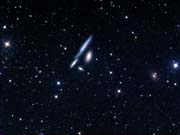 |
|
Although in general this season has been very disappointing the Arctic air high pressure system in early April continued to provide clear skies albeit with limited imaging time with the approach of twilight nights. The night of April 12th 2021 was again clear and I was able to capture data for this image. Messier 61 is a slightly distorted face on mag 9.3 spiral galaxy in Virgo. I have imaged it a couple of times in the past, the most recent being in 2007 but it was long overdue for a repeat visit to capture the fainter outer areas. This is one of the largest galaxies in the Virgo cluster and very active with several supernovae observed in recent years. QSI683 with SX AO unit on RC10. Luminance 14 x 10 minutes, RGB each 6 x 10 minutes all binned 2x2. The camera was actually rotated 90 degrees to provide a suitable guide star, so the image is cropped for a more pleasing North up view. The medium sized full image is available here. The other two notable galaxies (from right to left) are mag 12.9 NGC 4301 and mag 12.2 NGC 4292. Full Size |
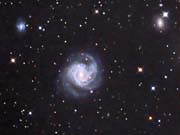 |
|
Yet another clear night on 14th April 2021! Making up for time lost this season and not to be wasted, but relatively short periods of darkness late at night. Sleep deprivation looming large! Elliptical galaxies are generally pretty nondescript objects to image, although of course they are amazing things usually containing billions of stars and a huge black hole, believed generally to be the result of galaxy mergers. Messier 60 (NGC4649) is a large magnitude 8.8 elliptical galaxy in Virgo, and this is the first time I've imaged it - I'd overlooked it as a run of the mill elliptical. But when I saw a Hubble image I realised that it has an interesting neighbour, magnitude 11.4 spiral galaxy NGC 4647. It's not certain whether the two are interacting, or the spiral is further away from us, but they make an interesting pair. The edge on galaxy in the bottom right corner is mag 11.1 NGC 4638. QSI 683 with SX AO unit on RC10. Luminance 12 x 10 minutes, RGB each 6 x 10 minutes all binned 2x2. Full size This image appeared in the June 2021 Astronomy Now Gallery |
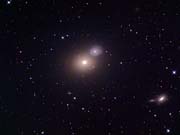 |
|
The Siamese Twins, also known as the Butterfly Galaxies interacting pair in Virgo is seperately identified as (upper to lower) mag 12 NGC4567 and mag 11 NGC 4568. The galaxy at the top of the image is mag 11 NGC4564, and the tiny one at the bottom, mag 14.4 IC 3578. Yet another beautifully clear night on 15th April - the 5th out of seven. I need an early night! But I'll have managed 6 nights imaging this month which although limited time as Summer approaches has helped to make up a bit for the generally terrible season. QSI683 camera with SX AO unit on RC10 truss. Luminance 14 x 10 minutes. RGB each 5 x 10 minutes all binned 2x2 Full Size |
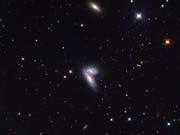 |
|
It's many years since I imaged M51 - the last time was in 2011 shortly before a supernova was discovered, and then the supernova itself. This last week or so with all the clear nights I've been catching some fainter objects. But the night of 16 April was yet again clear so I decided to go for an easier target and since it was almost directly overhead had a go at M51 despite the crescent Moon in the West. With this result. QSI683 with SX AO unit on RC10. Luminance 11 x 10 minutes, RGB each 5 x 10 minutes, all binned 2x2. Full size
But there's more to M51 than meets the eye as witness this heavily stretched version. Obviously that will need much more data to lose the heavy background noise. but it's interesting to see how far out the faint extensions go. It'll have to be next year now. |
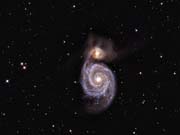
|
|
This took a few weeks with all the cloudy weather at the start of the imaging season in August 2021. But at last the two nights of 6th and 7th September finally let me finish data collection. IC1396 was riding high in Cepheus at the time, crossing the meridian almost overhead for me, so although some subs were taken during Astronomical twilight , being narrowband they haven't suffered too much. This is a mosaic of two images with my QSI 683 on TS quad 65 (420 mm fl). 20 minute subs needed so quite a lot of time. In the end Ha was two sets of 10 subs. OIII and SII two sets of 6 subs, all 20 minutes each, all unbinned. So total exposure time 15 hours. Plus of course time spent messing around realigning the camera etc. for each session. This image is mapped HOS to RGB, with some colour tweaking to produce the blue area. I tried a number of different processes, but this was considered to be the most pleasing! Larger image The iconic Elephant's Trunk nebula (VdB142) is featured of course, and also imaged in close up here. |
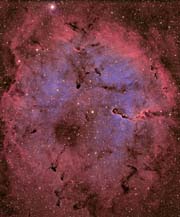 |